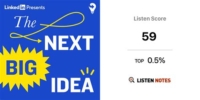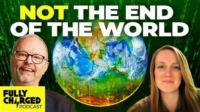
This is the first of three posts which I’ll write in the next week or so. I plan to use them in which I’ll to and which my regular readers may not know about.
Let’s start with the organization—the Next Big Idea Club.
Sometime in late 2018 I got a newsletter from Adam Grant, announcing a new book club that he was a part of. Since I’ve never been a fan of book clubs, I’m not sure why I even bothered to look, but I’m glad I did.
The Basic Club
What first grabbed my metaphorical eye was the fact that it was to be curated by four of my favorite authors—Malcolm Gladwell, Daniel Pink, and Susan Cain in addition to Grant. Each quarter, they would send members two new non-fiction trade books that they and their team selected. At the time, they also planned to send a copy of each book to a high school student in an underserved community somewhere in the United States.
 Although they didn’t emphasize this point, they were planning to focus up and coming authors at least some of whom I might not otherwise find out about. In fact, I had initially stumbled on Grant’s first book through some form of dumb luck. And, since I read widely and typically consume two or three non-fiction books a week
Although they didn’t emphasize this point, they were planning to focus up and coming authors at least some of whom I might not otherwise find out about. In fact, I had initially stumbled on Grant’s first book through some form of dumb luck. And, since I read widely and typically consume two or three non-fiction books a week
If I remember right, I’ve now gotten 22 boxes of books plus study guides, book marks, and pencils. The most recent box had Adam Alter’s Anatomy of a Breakthrough and Amy Edmonson’s The Right Kind of Wrong as well as a bonus copy of Grant’s newest, Hidden Potential. I have devoured each of them and found ways of incorporating their authors’ insights into the book Patricia Shafer and I are writing, Peace is a Verb.
Not all of books feed that directly into my own work. However, I haven’t gotten a book that I haven’t enjoyed or learned from. And, as I look at my bookshelf, at last two thirds of them are by authors I would never have heard of otherwise.
The Club Evolves
The club has evolved in a number of ways in its brief five-year life.
Only one could be seen as a step backward. Because it hasn’t found a good way of distributing books to high school students who would actually read them, it has put that part of its work on hold—though, again, see the next section.
As has been the case with most new and successful business ventures, most of the positive steps forward have come through its mobile app which lets you do lots of things, but those things do not include actually reading the books in the app. You still need a Kindle.
The club now publishes lists of books. They started with a short list of books they were considering for the next box. Now, they issue a much longer list of the most interesting books that cross the curators’ desks each quarter. They’ve also begun compiling lists by topic. Today (January 29, 2024) it has next season’s finalists as well as suggestions for books on language, worrying less, financial literacy, music, quirky takes on history, life hacks, and more.
There is one danger here, of course. One can buy and read a book only to discover that ikt is included in the next box. That has happened to more than once, which means that Patricia and her husband will get a nice box of books as a house warming gift when they move to Washington DC next month.
I get the most from its more or less weekly podcasts in which one of the staff members interviews an author. They are about the right length for me because I can listen to one during my daily two to three mile walk. Last Friday, for example, I heard an interview with Hannah Ritchie discussing her new book, Not the End of the World, which I immediately had whisked to my Kindle the minute I got home because I’ve long been looking a solutions-oriented book on climate change (spoilers alert—it’s well worth the read).

It also issues challenges to its readers and presents short “book bites” in which authors provide short summaries, usually of the five most important ideas in their books. It even is experimenting with publishing itself, now including a roll out of an oral vesion of Steven Johnson’s latest, Immortality: A User’s Guide, which is currently only available to club members and to paid subscriber’s to Johnson’s substack feed (which is also well worth it, by the way.
Turning in into a “Real Club”
I haven’t fully taken advantage of the club as a club—at least until now, that is. In part, because it hasn’t really been a club like Rotary or the Yankees fan clubs I lurk in. All the information has come from the club to its members.
While that was fine for what I though I wanted, it “ain’t a real club” where one goes to hang out and maybe even learn something along the way.
A few weeks ago, I received a notification that charter members were being invited to join its “innovators” site on Linkedin. I did but didn’t explore what was on it until I got an email from co-found Chris Chaput, who is charger of UX (I’m a nerdy cool 76 year-old showoff who will make readers who aren’t in the know look up what UX stands for). He wanted us to fill out a survey about how we “innovators” wanted to be connected to the club.
It then finally dawned on me that it really isn’t (yet) much of a club whose members can participate in above and beyond reading the books. Because I’ve been asked to help build locally based peacebuilding and social change movements, I had already been thinking about how best to turn passive onlookers into real live activists. So, I took him up on his offer to book a time to talk.
Once we did, I realized that it would be a lot of fun to explore ways of engaging members with each other through the books they read. There are a few groups that have met face-to-face to discuss the books, including one here in Washington.
However, couldn’t we do more?

So, Chris and I have begun talking about creating online and Zoom-based discussion forums on the books they features, perhaps starting with Ritchie’s book on climate change. That starts with creating traditional book clubs from NBIC’s existing members.
Its members, after all, are likely to be interested—if not always interesting—people. Couldn’t active discussion groups create another reason for people to stay in the club? Or become brand champions who help convince their friends to join, too? Might I even find people to join my own networks of locally based activists which we are beginning to incubate at the Alliance for Peacebuilding?
When we talked, I also raised the possibility of reviving the program to give books to needy and deserving high school students, since my co-author Patricia leads a network of fifteen thousand or so peacebuilders who are still in high school.
The Bottom Line
The Next Big Idea Club isn’t for everyone—even for all voracious readers of non-fiction. But, for someone who reads as widely as I do, it has become a godsend that—thanks for Chris’s prodding—I now check daily. In fact, there are a couple of messages on the Innovators page waiting for my response now.
The views and opinions expressed in this article are those of the author and do not necessarily reflect the official policy or position of the Alliance for Peacebuilding or its members.
